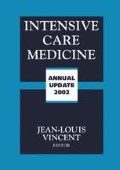Abstract
Lung function is often compromised in respiratory failure. Therefore, the management of mechanically ventilated patients is facilitated by knowing the mechanical properties of the patient’s lungs. Monitoring mechanical lung function regularly may help in the diagnosis of adverse events such as onset of pulmonary edema or blockage of the endotracheal tube. Ventilator-induced lung injury (VILI), due to over-stretch of the pulmonary tissues, may be minimized if the relationships between volume, flow and pressure in the lungs are understood and ventilatory parameters are chosen accordingly.
Access this chapter
Tax calculation will be finalised at checkout
Purchases are for personal use only
Preview
Unable to display preview. Download preview PDF.
References
Mead J, Whittenberger JL (1953) Physical properties of human lungs measured during spontaneous respiration. J Appl Physiol 5: 779–796
Peslin R, Felicio da Silva J, Chabot F, Duvivier C (1992) Respiratory mechanics studied by multiple linear regression in unsedated ventilated patients. Eur Respir J 5: 871–878
Dechman GS, Chartrand DA, Ruiz-Neto RP, Bates JHT (1995) The effect of changing end-expiratory pressure on respiratory system mechanics in open-and closed-chested anesthetized, paralyzed patients. Anesth Analg 81: 279–286
Fahy BG, Barnas GM, Nagle SE, Flowers JL, Njoku MJ, Agarwal M (1996) Effects of Trendelenburg and reverse Trendelenburg postures on lung and chest wall mechanics. J Clin Anesth 8: 236–244
Fredberg JJ, Keefe DH, Glass GM, Castile RG, Franz ID (1984) Alveolar pressure nonhomogeneity during small-amplitude high-frequency oscillation. J Appl Physiol 57: 788–800
Hantos Z, Daroczy B, Suki B, Nagy S, Fredberg JJ (1992) Input impedance and peripheral inhomogeneity of dog lungs. J Appl Physiol 72: 168–178
Otis AB (1986) History of respiratory mechanics. In: Cherniack NS (ed) Handbook of Physiology. The Respiratory System, vol III. Am Physiol Soc, Bethesda, pp 1–12
Fabry B, Guttman J, Eberhard L, Wolff G (1994) Automatic compensation of endotracheal tube resistance in spontaneously breathing patients. Technol Health Care 1: 281–291
Guttman J, Eberhard L, Fabry B, et al (1995) Time constant/volume relationship of passive expiration in mechanically ventilated ARDS patients. Eur Respir J 8: 114–120
Bersten AD (1998) Measurement of overinflation by multiple linear regression analysis in patients with acute lung injury. Eur Respir J 12: 526–532
Salazar E, Knowles JH (1964) An analysis of pressure-volume characteristics of the lungs. J Appl Physiol 19: 97–104
Colebatch HJH, Ng CKY, Nikov N (1979) Use of an exponential function for elastic recoil. J Appl Physiol 46: 387–393
Harris RS, Hess DR, Venegas JG (2000) An objective analysis of the pressure-volume curve in the acute respiratory distress syndrome. Am J Respir Crit Care Med 161: 432–439
Hickling K (1998) The pressure-volume curve is greatly modified by recruitment. Am J Respir Crit Care Med 158: 194–202
Otis AB, McKerrow CB, Bartlett RA, et al (1956) Mechanical factors in distribution of pulmonary ventilation. J Appl Physiol 8: 427–443
Mead J (1969) Contribution of compliance of airways to frequency-dependent behavior of lungs. J Appl Physiol 26: 670–673
Mount LE (1955) The ventilation flow-resistance and compliance of rat lungs. J Physiol (Lond) 127: 157–167
Similowski T, Bates JHT (1991) Two-compartment modelling of respiratory system mechanics at low frequencies: gas redistribution or tissue rheology? Eur Respir J 4: 353–358
Bates JHT, Ludwig MS, Sly PD, Brown K, Martin JG, Fredberg JJ (1988) Interrupter resistance elucidated by alveolar pressure measurement in open-chest normal dogs. J Appl Physiol 65: 408–414
Fredberg JJ, Ingram RH, Castile RG, Glass GM, Drazen JM (1985) Nonhomogeneity of lung response to inhaled histamine assessed with alveolar capsules. J Appl Physiol 58: 1914–1922
Ludwig MS, Romero PV, Sly PD, Fredberg JJ, Bates JHT (1990) Interpretation of interrupter resistance after histamine-induced constriction in the dog. J Appl Physiol 68: 1651–1656
Rossi A, Gottfried SB, Higgs BD, Zocchi L, Grassino A, Milic-Emili J (1985) Respiratory mechanics in mechanically ventilated patients with respiratory failure. J Appl Physiol 58: 1849–1858
D’Angelo E, Tavola M, Milic-Emili J (2000) Volume and time dependence of respiratory system mechanics in normal anaesthetized paralysed humans. Eur Respir J 16: 665–672
Bates JHT, Rossi A, Milic-Emili J (1985) Analysis of the behavior of the respiratory system with constant inspiratory flow. J Appl Physiol 58: 1840–1848
Peslin R, Fredberg JJ (1986) Oscillation mechanics of the respiratory system. In: Cherniack NS (ed) Handbook of Physiology, The Respiratory System, vol III. Am Physiol Soc, Bethesda, pp 145–177
Beraldo PS, Mateus SR, Arujo LM, Horan TA (2000) Forced oscillation technique to detect and monitor tracheal stenosis in a tetraplegic patient. Spinal Cord 38: 445–447
Kaczka D, Ingenito EP, Body SC, et al (2001) Inspiratory lung impedance in COPD: effects of PEEP and immediate impact of lung volume reduction surgery. J Appl Physiol 90: 18331841
Editor information
Editors and Affiliations
Rights and permissions
Copyright information
© 2002 Springer Science+Business Media New York
About this chapter
Cite this chapter
Bates, J.H.T. (2002). Assessment of Lung Function in Mechanically Ventilated Patients. In: Vincent, JL. (eds) Intensive Care Medicine. Springer, New York, NY. https://doi.org/10.1007/978-1-4757-5551-0_52
Download citation
DOI: https://doi.org/10.1007/978-1-4757-5551-0_52
Publisher Name: Springer, New York, NY
Print ISBN: 978-1-4757-5553-4
Online ISBN: 978-1-4757-5551-0
eBook Packages: Springer Book Archive

